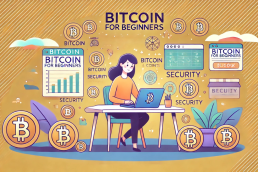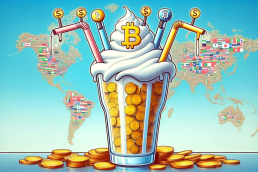A debt based monetary system
I believe this topic is very interesting.
Because you hear a lot of debate lately about our current financial system and most wonder if it is sustainable due to it mostly being build around debt.
Also, you hear people arguing about what is the best form of money (gold, fiat, Bitcoin) without taking into account that there currently is a whole system build around it that makes it work. In other words, if you simply decide to replace the dollar or the debt with Bitcoin or Gold, the whole system falls apart within an instant even though both examples are clearly better forms of money in a classical sense.
Why? Because we have a debt based monetary system.
In a debt-based monetary system, the money supply is largely created through the process of borrowing and lending.
Here’s how it works:
- Fractional Reserve Banking: Most modern banking systems operate on a fractional reserve basis. This means that banks are required to hold only a fraction of their customers’ deposits as reserves, while they can lend out the rest of the money. For example, if the reserve requirement is set at 10%, a bank can lend out 90% of the deposits it receives.
- Money Creation through Lending: When a bank lends money to a borrower, it creates new money in the form of a loan. This newly created money is added to the money supply, effectively increasing the total amount of money circulating in the economy.
- Debt as Money: The money created through lending is essentially a form of debt. When a bank issues a loan, it is creating an asset (the loan) and a liability (the deposit made into the borrower’s account). The borrower now owes the bank the amount of the loan, and the bank holds the borrower’s promise to repay as an asset on its balance sheet.
- Repayment and Destruction of Money: As the borrower repays the loan, the money is effectively destroyed. The borrower’s debt is extinguished, and the money is removed from circulation. This process of lending and repayment is a continuous cycle in the debt-based monetary system.
Alright, let’s break this down. Our money has value because it’s tied to debt. The “asset” that makes money valuable is actually “debt.” When we have a dollar or euro, it’s like a promise that we’ll be paid back with something of real value in the future. You know, it’s not the money itself we want, but the stuff we can buy with it, like goods and services. We trust that whenever we spend the money, it’ll still be worth what we expect. And that trust comes from the fact that the money has “debt” backing it up. This creates a (future) demand for dollars, and that’s what gives money its value.
A dollar, euro, or any other form of fiat currency represents a claim on the underlying economy and the goods and services it produces.
How fiat as “currency” & debt as “asset” works in real life
Now that we know how this works, we also should be able to see why this is unsustainable. If the whole system, exists of “fractional reserve banking”, “money creation through lending” & “debt as money”, it’s not difficult to see why we get way more debt in the system than we have actual money to ever pay it back.
- Banks only need to have 10% of depositors money as reserves, the rest is being lend out
- The money that is being lend out, becomes deposits on someone else’s bank after it is spend and so gives another bank the opportunity the lend out even more (multiplier effect)
So, let’s explain why we have more debt than actual money with an easy example:
We have more debt than actual money because of the way banks work with our money.
Let’s imagine you have a piggy bank with $100 in it. When a bank comes along and asks to borrow that $100 from you, you agree and lend them the money.
Now, here’s where it gets interesting. The bank doesn’t just keep your $100 safe in its vault. Instead, it lends most of that money to other people and businesses who need it. So, let’s say the bank lends $90 to someone who wants to buy a cool new bike. That person takes the $90 and buys the bike.
Now, guess what? The bike shop owner, who got the $90, goes back to the bank and deposits it back in. So now, the bank has $100 from your original deposit and an extra $90 from the bike shop owner, making a total of $190 in deposits.
But hold on, the bank is only required to keep a portion of those deposits as reserves, like maybe 10% (it’s called the reserve requirement). So, the bank keeps $19 (10% of $190) as reserves and can lend out the remaining $171 to someone else who needs money.
This process keeps repeating, with the bank lending out money from deposits and creating new loans, while keeping a small part as reserves. As a result, the original $100 you deposited in the bank has now led to the creation of more than $100 in new loans. That’s why we have more debt than actual money!
Remember, all the money created through loans also comes with a debt attached to it. Each loan the bank makes means someone has to pay that money back, so it becomes a debt.
A vicious cycle: debt doom loop
So, to sum it up, we end up with more debt than actual money because when banks make loans, they create new money in the process, which expands the total money supply beyond the physical cash we started with. And all that new money is tied to debts that borrowers owe to the banks.
Currently, the ratio actual dollars against actual debt is 1:10. In other words, if people would come for their “real money”, only 10% is able to get it and the rest is left holding the bag! Which is why, every time we have some sort of a crisis, the Central Banks need to print more monetary units to make sure people can get their hands on their money. But, by doing that, the Central Banks are hugely devaluing the monetary units in existence by creating more of them out of thin air. This proces “steals” value from savers and workers of the low & middle class. In other words, this leads to more wealth inequality over time.
This of course is unsustainable because the system is structured to forever inflate the money supply in order to be partially able to pay off existing debt and the interest on it. Only for keeping the system afloat.
By doing so, creating more debt in the process and so a higher demand for future dollars which creates a vicious cycle & a debt doom loop in the end.
Want to learn more about what it means to become a member of our community and be able to check out way more in depth content so you can learn how to benefit from the global transition that is taking place? https://cryptounseen.com/crypto-unseen-community
Want to learn more about “the Why, What & How of Bitcoin” sign up here for the free monthly training: https://cryptounseen.com/free-2-hour-training-about-the-why-what-how-of-bitcoin-crypto
Also, follow us on LinkedIn, Instagram and/or my personal Twitter here.
Subscribe to our free newsletter!
Marc
Meet Marc—with a unique history of studying psychology, poker, and performing sales on high levels, he eventually ended up with a curious eye for the world of money. He dove into traditional investing and even surfed the wild waves of "shitcoins" in the crypto space. But it was the wake-up call of the 2020 pandemic that really opened his eyes to the true power governments wield and how little control individuals have over their financial destiny. The broken fiat currencies within the traditional financial system and the rampant scams, lies, and rug-pulling in the crypto space lit a fire within him, driving his unwavering enthusiasm for 100% Bitcoin.
Fueled by this newfound awareness and his connection with a company called Awake Origins, Marc embarked on a remarkable spiritual journey, selling everything and traveling the globe with his family for nearly three years. Along the way, he couldn't help but ponder some big questions about money, economics, and global wealth disparities. These musings eventually led him to the fascinating world of Bitcoin, a place he's never looked back from. Today, Marc dedicates his time to helping folks and businesses seamlessly integrate Bitcoin into their daily lives, all while continuing his global adventures.


